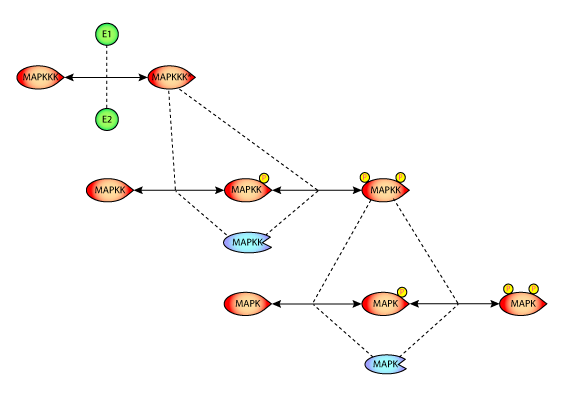Huang, Ferrell, 1996
Model Status
This CellML model runs in both OpenCell and COR to reproduce the results given by running the Mathematica description of the model (provided by the original model author) using the Mathematica NDSolve integration algorithm. The units have been checked and they are consistent.
Model Structure
ABSTRACT: The mitogen-activated protein kinase (MAPK) cascade is a highly conserved series of three protein kinases implicated in diverse biological processes. Here we demonstrate that the cascade arrangement has unexpected consequences for the dynamics of MAPK signaling. We solved the rate equations for the cascade numerically and found that MAPK is predicted to behave like a highly cooperative enzyme, even though it was not assumed that any of the enzymes in the cascade were regulated cooperatively. Measurements of MAPK activation in Xenopus oocyte extracts confirmed this prediction. The stimulus/response curve of the MAPK was found to be as steep as that of a cooperative enzyme with a Hill coefficient of 4-5, well in excess of that of the classical allosteric protein hemoglobin. The shape of the MAPK stimulus/ response curve may make the cascade particularly appropriate for mediating processes like mitogenesis, cell fate induction, and oocyte maturation, where a cell switches from one discrete state to another.
The original paper reference is cited below:
Ultrasensitivity in the mitogen-activated protein cascade, Chi-Ying F. Huang and James E. Ferrell, Jr., 1996, Proc. Natl. Acad. Sci. USA , 93, 10078-10083. PubMed ID: 8816754
 |
| Schematic diagram of the MAPK cascade described by the model. |
